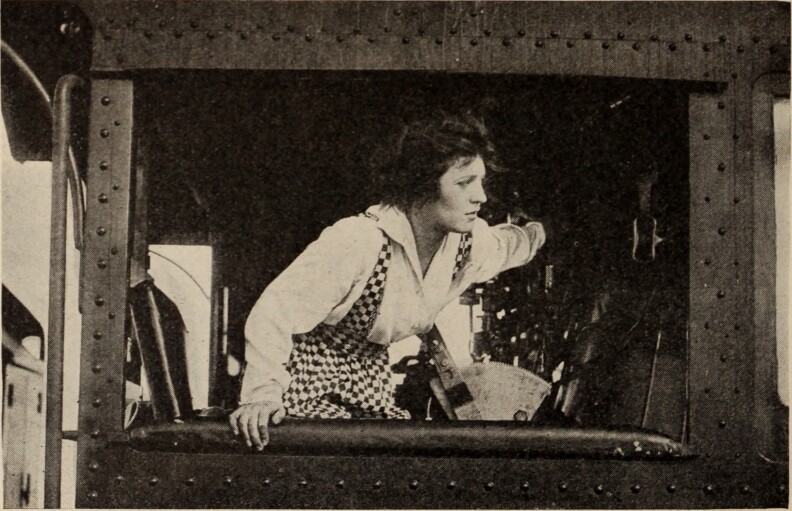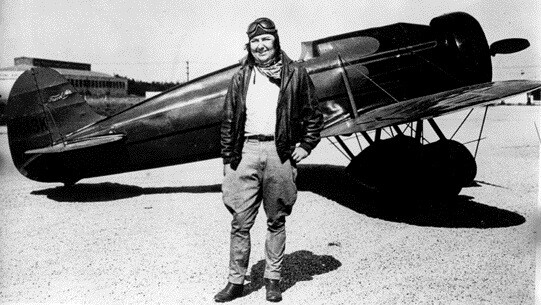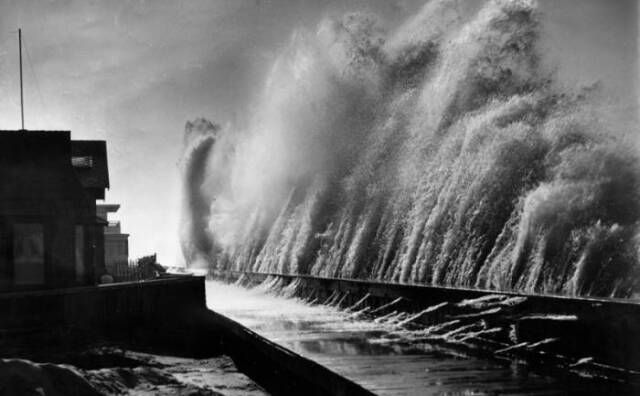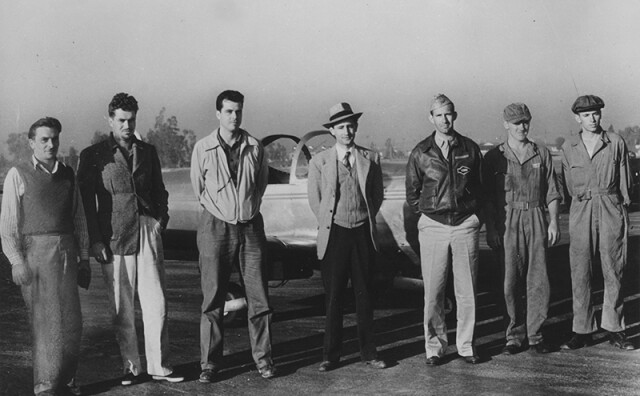When you think of the early 20th century, some of the first words that come to mind may be misogyny, racism, and conformity — an era when women and people of color were constrained in all aspects of their lives — epitomized by constricting hobble skirts that women had to wear.
While all this was true, many brave women flocked to Southern California and bucked the system, becoming some of the most famous daredevils and extreme athletes of their time. In the wide-open spaces of the West, rodeos flourished, the aerospace industry grew, and the budding entertainment industry made these female daredevils an essential part of the action.
Death Defying Leap
On July 4th, 1888, Los Angeles became enthralled by the enigmatic Mrs. Van Tassel of San Francisco. In front of a massive crowd, she parachuted from a balloon on the corner of Los Angeles and Aliso Street in downtown L.A., making her possibly the first woman in America to make the death-defying leap.
As she told the Los Angeles Times:
“I often dreamed of falling immense distances, and I wanted to see how it was, I ain't exactly a bird nor an angel, but it's just about what I imagine the sensation of flying is. It was beautiful! Though I went through that 6,000 feet in 5¼ minutes, I didn't seem to be going fast and never lost my breath. I swung hundreds of feet one side and the other for the first 4,000 feet, but after that, I just floated down an incline to the ground and alighted with no more shock than would be caused by jumping off a chair.”
-
Nonprofit's launching fundraiser to keep it afloat
-
USC study documents what residents want from trees
-
What candidates can — and can't — say they do
Mrs. Joe Jinnett, a local racing legend, was known to track a mile on her horse Zomwoosley in 2 minutes 14 seconds at the old Exposition Park, making her the second woman in America to achieve such a feat. Of course, in 1913, while celebrating her upcoming country-wide tour, the L.A. Times assured readers that Mrs. Jinnett was the “illustration of outdoor, healthy womanhood” and “not a horsey woman” but “merely one who takes to this form of exercise as a duck does to water.”
Million Dollar Mermaid
However, beliefs about women’s health and wellness were changing. The internationally famous long-distance swimmer Annette Kellerman, who appeared in the “Million Dollar Mermaid,” wrote a column for the L.A. Times encouraging women to shed their cumbersome corsets and jump, dive, and run, regardless of what society thought. Her views gained traction in Southern California, and she ran a health food store in Long Beach.
Another group also helped transform the way women were perceived — the fearless actresses and stuntwomen of silent Hollywood. “When women performed such stunts onscreen, they confounded all expectations of proper feminine behavior,” Mollie Gregory writes in the fascinating Stuntwomen: The Untold Hollywood Story. “Their exploits opened a new view of the modern woman and her astonishing possibilities.”
Gregory notes during the 1910s, many of the most popular serial films were action adventures starring women. Serials like The Perils of Pauline, The Hazards of Helen, The Adventures of Kathlyn, The Red Circle, and The Purple Mask drew large crowds throughout America, encouraging women as they fought for the right to vote.
'One Of The Nerviest Girls In Pictures'
The stuntwomen who stunned the nation were some of the most fascinating people in Los Angeles. The screenwriter and serial star Grace Cunard was an expert race car driver, who, Gregory notes, “drove like a maniac”, and proclaimed “no speed is great enough to please me.” Then there was actress Ruth Roland, a beautiful movie queen who did her own aerial stunts and didn’t mind when real bullets were fired at her feet. According to Gregory, this earned her the reputation as “one of the nerviest girls in pictures.”
Infuriatingly, by the 1930s, many stuntwomen were pushed out of business and replaced with male stunt performers wearing wigs. But just as some talented women were being oppressed, female aviation pioneers flourished, keeping the adventurous flame alive. “Ah, hell,” the legendary aviator Florence “Pancho” Barnes once said. “We had more fun in a week than those weenies had in a lifetime.”
Here are some of the most daring women:
Helen Holmes and Helen Gibson

Originally from the Midwest, Helen Holmes loved racing cars and honed her stunt driving skills at Mack Sennett’s Edendale studios in Silverlake, home of the Keystone Kops. In 1914, she started the first of The Hazards of Helen series, in which she played a fearless, independent woman who repeatedly saved the day. Holmes starred in 48 of the wildly successful shorts and full-length films.
“The filmmaking mayhem at Keystone was good training for Helen’s later stunts,” Gregory writes, “including driving her car at top speed off a dock at San Pedro harbor and making a thirty-foot jump onto a barge for an episode of The Railroad Raiders. Fearless, she succeeded on the fourth try.”
But Holmes was aided in some of her stunts by Helen Gibson, often referred to as America’s First Stuntwoman. Like many early stunt people, Gibson grew up in the Wild West and became an expert trick rider and rodeo performer at a young age. Lean times on the circuit brought her to Hollywood, where she quickly rose from cowboy extra to Helen Holmes’s stuntwoman. Gregory writes:
"In one stunt she was supposed to leap from the roof of the station to the top of a moving train. “I was not nervous as it approached and I leaped without hesitation,” she recalled. She landed safely, but the rocking motion of the train rolled her straight toward the end of the car. Just before being pitched off, “I caught hold of an air vent and hung on.” Then, with a sense of the dramatic, Gibson let her body “dangle over the edge to increase the effect on the screen.”

After Holmes left to pursue other ventures, Gibson took over the titular role in The Hazards of Helen, becoming a star in her own right. “Screen acting,” she recalled, “was often a matter of guts.”
Nina Vitagliano

Auto-madness swept Southern California in the early 20th century, as auto clubs and rudimentary tracks sprang up all over the region’s great expanse. Racing became a pastime, particularly for the wealthy. According to Elsa A. Nystrom, author of the thrilling Mad For Speed, women drivers raced at Ascot Park, at the Central and Florence Avenues intersection. It was an all-female affair, with women officiating the races and even working as crew in the pits, fixing cars themselves.
In 1918, a group of drivers, nicknamed the Speederettes, organized the first large-scale women’s exhibition race at Ascot Park. “Although the Los Angeles Times had initially referred to the February races at Ascot disparagingly as ‘Sunday’s Big Girlie Show,’ the event drew 10,000 people to the mile concrete oval,” Nystrom writes. “Those who came to scoff or out of curiosity were impressed by the determination of the Speederettes.”
One of the women in the race was impetuous, speed-mad Nina Vitagliano, whose aristocratic Italian family had relocated to Los Angeles. After the race, fellow racer and future aviatrix Ruth Wightman challenged Vitagliano to a one-to-one battle at the Stockton Fairgrounds during the next marquee women’s racing event.
The day turned out to be disastrous when Vitagliano lost control, attempting to pass Wightman, and crashed her car into a tree. She was killed instantly. But the show went on. “Although a few of the women withdrew from the competition after Vitagliano was killed,” Nystrom writes, “the majority finished the rest of the races with heavy hearts, although they must have been keenly aware of the danger.”
Bobbi Trout

One spring afternoon in 1918, Bobbie Trout was walking from school in Illinois when she saw a plane pass overhead. That moment would change her life. “It thrilled me to death!” she recalled. “I thought, ‘I’ve got to fly someday!’”
The Trout family relocated to Southern California in 1920 and bought a gas station. While learning to fly, Trout crashed but survived with just several stitches over one eye.
In 1929, the poised and charming Trout, with her stylish bobbed hair, became a national celebrity when she broke the endurance record for most time spent piloting a solo flight. Air Travel News reported:
An endurance flight of Twelve hours and Five Minutes made by Miss Bobbie Trout, an 18-year-old aviatrix, established a new world mark for sustained flight by a woman flyer at the Metropolitan Airport, Los Angeles, on Wednesday, January 2nd...The dawn-to-dusk flight commenced near Van Nuys, at the above airport, at 6:25 am. The young woman made a perfect landing although it was after nightfall. A piercing beacon light guided her onto the field. She did not appear to be greatly fatigued and stood in the cockpit of her Golden Eagle ship to wave to the large crowd which had gathered.
According to historian Paul R. Spitzzeri of the Homestead Museum, fellow aviator Elinor Smith, the youngest federally licensed pilot, quickly shattered Trout’s record by two hours. Trout quickly reclaimed the record. In a brilliant PR move, the two rivals soon joined forces. Spitzzeri writes:
In fall of 1929, Trout and Smith decided to team up to break the endurance record allowing for refueling, a distinction that they were the first women to achieve. The flight, originating from Metropolitan Airport in Van Nuys, was to occur in rotation around the San Fernando Valley, into modern Santa Clarita, west to Santa Paula, and back to Van Nuys.
The women successfully stayed in the air for 42 hours. That same year, Trout became even more famous when she participated in the inaugural Women’s Air Derby, known derisively in the media as “the powder puff derby.” Nineteen female pilots, including Amelia Earhart, took off from Santa Monica in a race toward Cleveland, Ohio. In 1931, Trout and aviator Edna May Cooper successfully bested the record she and Smith initially set by staying the air for an amazing 123 hours.
“What do I love about it? What does anybody love about it? You can go places and fly like a bird,” she told a reporter for Airport Journals years later. “When people years ago, in the Stone Ages, saw birds fly around, they must have thought, ‘Oh, isn’t that wonderful? Wouldn’t it be wonderful if we could only do that?'”
Marie Dickerson Coker

“I was working Culver City at the Chicken Coop when these pilots walked in. Those days it was something to be a pilot, let alone a black one. Anyway, they asked if I would like to go for a flight and I said yes,” pioneering aviator Marie Coker remembered in the Los Angeles Sentinel.
“[A] very high-spirited, entertaining lady,” according to historian Philip Hart, the effervescent and daring Coker was a singer and dancer who performed at famed jazz clubs throughout Los Angeles. She was soon taking lessons with the pioneering aviator and promoter William J. Powell at his groundbreaking Bessie Coleman Aero Club on Jefferson Boulevard.
Powell invited her to join the Blackbirds, his all-Black flying team. “This is going to be the greatest thing that you have ever gotten into,” he told her. On Dec. 6, 1931, she flew in formation with the Blackbirds in the legendary Colored Air Circus at Eastfield Airfield in front of tens of thousands of spectators.
The fearless Coker was modest about her skills, later recalling:
“[Powell] would lead, the first one would fall off, then the second one, then the third one, and we would make a line and come on back around and make another string and come off. That's all we did, and that was good enough.'"
Pancho Barnes

“Flying makes me feel like a sex maniac in a whorehouse with a stack of $20 bills,” the legendary Pancho Barnes, a San Marino native, once exclaimed in her characteristic outrageous style.
Barnes was the ultimate SoCal daredevil — the hell-raising, hard-partying granddaughter of pioneering Civil War balloonist Thaddeus Lowe. Lauren Kessler’s poignant The Happy Bottom Riding Club: The Life and Times of Pancho Barnes describes how he introduced his granddaughter to the thrills of the West as a child:
Every Sunday, the old man would take his granddaughter on another adventure. They trekked by mule up the San Gabriel Mountains, cheered in the stands at Buffalo Bill’s Wild West Show, sat side by side on a hard bench under the Ringling Brothers big top watching a parade of trained elephants, toured alligator farms and ostrich ranches, visited expositions, horse shows, and amusement parks.
The thrill-seeking Barnes was soon a celebrated pilot, competing in races and working as a test pilot for Lockheed. She became a stunt pilot performer and organizer for movies including Hells Angels, Air Mail Pilot, The Lost Squadron, and Young Eagles, and she founded the Associated Motion Picture Stunt Pilots Union. Determined that women should have a place on the national stage, she founded the Women’s Air Reserve, which is devoted to providing fly-in care and supplies to people from low-income backgrounds.
But her legend was cemented in 1935 when she founded the infamous and rowdy fly-in private club and dude ranch known as The Happy Bottom Riding Club. Located in the Mojave Desert, where Edwards Air Force Base now stands, Barnes provided liquor and mentorship to countless aviators.
According to Kessler, the always outspoken Barnes was furious when a casual pilot questioned whether elite pilots Bob Hoover and Chuck Yeager could break the sound barrier. “These two can fly up your ass and tickle your right eyeball, and you would never know why you were farting shock waves,” she exclaimed.
In 1947, Yeager would indeed break the sound barrier. The adventurous Barnes would continue her daring ways her entire life, living up to her reported motto: “Choose happy.”











